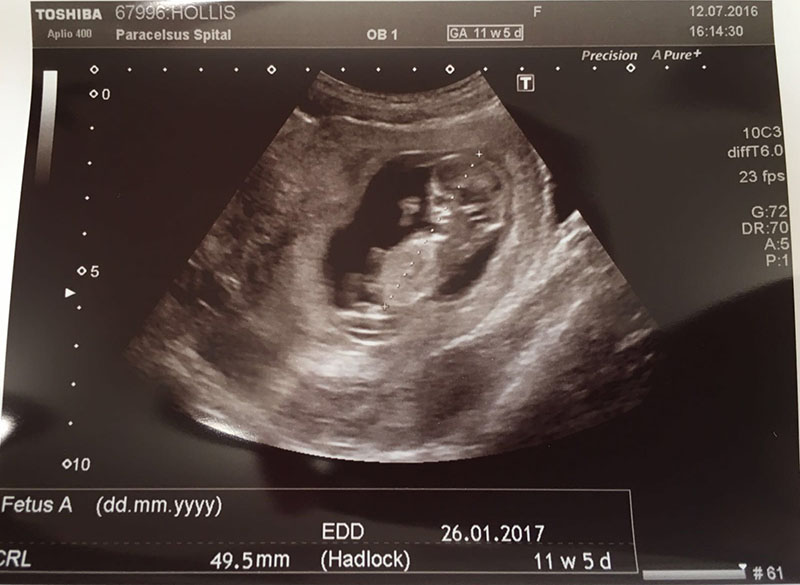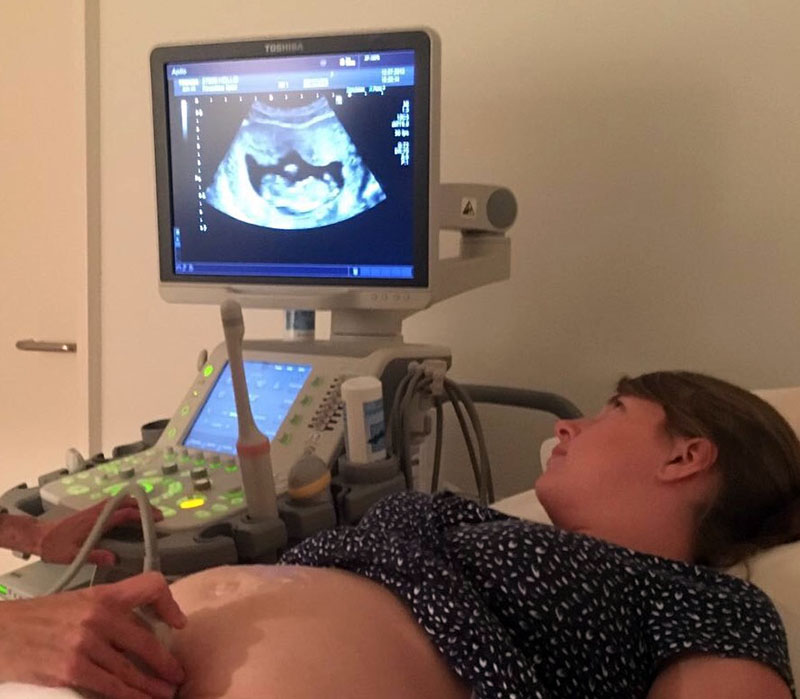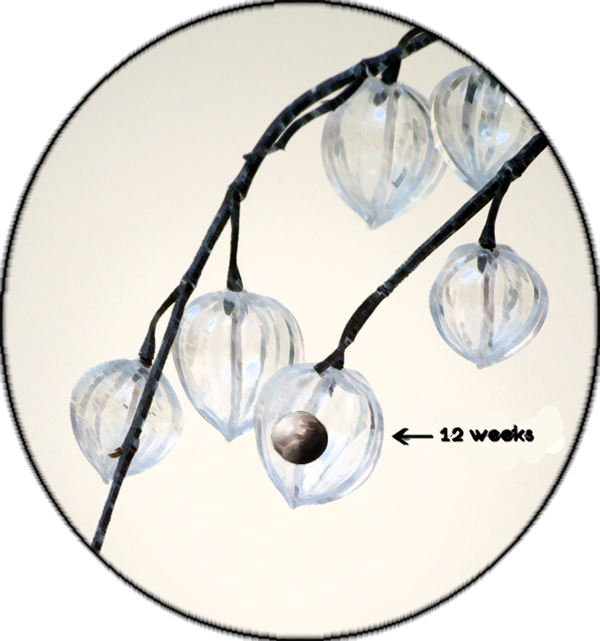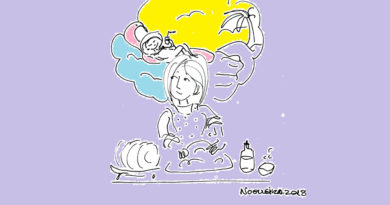My Battle with Morning Sickness Ends as War with the Sugar Monster Begins
The Expat Bump Diaries: Week 16
The nausea is easing, thank goodness! About two weeks ago I stopped taking the pills given to me by my gynaecologist, and although I still have some bouts of sickness, it seems to be waning. I think it has eased a little earlier than in my first pregnancy, and I also had a less sensitive sense of smell this time around. With my daughter, I remember standing out in the garden because I couldn’t stand the smell of chicken roasting in the oven, and I once had to run to the bathroom simply because I had put on a freshly washed jumper and the smell set my sickness off! It interests me how pregnancies are different – could it be a sign that it is a boy this time around?
My husband and I are still going back and forth on one of the first questions most people ask when they hear you’re expecting: “Will you find out the gender?” We didn’t with our first and it was such a magical surprise on the day, as we were both fully expecting it to be a boy because there are so many boys in both our families. It was a beautiful moment when my husband turned to me and said, “It’s a girl!” Of course I didn’t believe him and told him to check again. So I think we’re keen to have a surprise once more, but we’ve been warned that with the number of ultrasound scans you receive during the pregnancy here in Switzerland, it can be difficult to avoid finding out.
In the UK, you travel to your local hospital for routine scans at around 12 weeks and 20 weeks, with no more during the pregnancy unless there are complications (I had a few towards the end of my first pregnancy to check the size of the baby because I had gestational diabetes). Here in Switzerland you have in-depth scans at 8 weeks, 12 weeks and 20 weeks, where they take measurements of the baby and assess its development, but there are often many more in between. My gynaecologist has a scanner in her room, so every time I have an appointment she pulls it out and has a quick look to see how the baby is doing. It’s lovely to see the baby so often, but if it is a boy, it might be difficult to avoid noticing eventually!
At our 12-week scan it was incredible to see the difference just four weeks had made. The 8-week scan just showed a little blob with a tiny heartbeat, but by 12 weeks we could see that the baby had taken shape and was wriggling its arms and legs. The scan showed that all was well so far, so we could finally tell our friends and family that we were expecting Baby Number Two, and I could finally stop hiding how terrible I was feeling and covering up my already-ridiculously-big bump.

A blood test carried out at eight weeks revealed a complication: my thyroid was underperforming. This was a little scary, as after googling the problem I found out that it increased the risk of miscarriage in the first trimester. My gynaecologist put me on a medication to boost the thyroid and everything seems to be OK so far, fingers crossed. This test that is routine in Switzerland isn’t done in the UK unless you’re deemed high risk, so who knows – I may have had this issue in my first pregnancy without knowing it.

At 16 weeks I’ve just had my latest check-up with the gynaecologist and had my first test for gestational diabetes. Pregnant women in Switzerland don’t usually have a test for this until later in pregnancy (around 24 to 28 weeks), but because I was diagnosed with gestational diabetes during my first pregnancy, my gynaecologist wanted to have me checked early. The reason gestational diabetes can occur is that, as the baby grows, the placenta produces more hormones that block the insulin and provoke a rise in blood sugar. If you’re diagnosed with gestational diabetes, doctors say it is very important to control it; otherwise the baby may receive more glucose than usual and become bigger than in a normal pregnancy, and the baby’s blood sugar could crash after birth.
Most pregnant women in Switzerland first have the one-hour glucose-screening test, where they drink a sugary solution and then have their blood tested an hour later. Only if they fail this test do they have the three-hour glucose-tolerance test. Because of my history, I had to go straight to the three-hour test, which involves fasting overnight after 18:00 then going in to the hospital early and having the first blood test, drinking a sugary solution, then having a further two blood tests after one and two hours.
By the end you feel like a pincushion, but the truly difficult bit is drinking the solution. In the UK they use an energy drink you can buy in supermarkets, called Lucozade. The downside of Lucozade is that it is fizzy, and drinking more than 50 cl of bubbly, sweet drink on an empty stomach within 10 minutes is no easy task. In Switzerland the lady at the laboratory poured a powder into water. At the first sip I thought, “Well, it’s sweet but it’s flat, so it’s bound to be easier, right?” Wrong. She told me to drink it within 10 minutes and recommended I get it down as quickly as possible while holding my nose, “before the taste begins to stick in your mouth.” I followed her advice, and it took enormous strength to sit there and finish off that drink. After the first few gulps the sweetness was nearly unbearable. I found myself thinking towards the end, “I hope I actually get diagnosed at this stage, because if I don’t, the gynaecologist will want me to do this test again later in the pregnancy!” And it was nearly all for nothing: I found at the last mouthful that a heap of the solution had settled in the bottom of the glass, and I came extremely close to bringing it all back up again as the strong flavour hit me. Thankfully, I kept it down.
My second two blood tests were well within range, which meant that the sugar I had drunk was being processed properly, but my fasting rate was just over the borderline at 5.2 (the cut off is 5.1). As it was so close, I’m going back to redo the fasting test to check the result. If it is over the borderline again, even by 0.1, my gynaecologist says we should treat this as a diagnosis and I will begin more than five months of a strict diet and pricking my fingers several times a day to check my blood sugar levels. Not a lifestyle I will relish, but it’s best to play it safe as the most important thing is a healthy baby.
I’m still tracking the medical bills as they come in. This is something that those with Swiss insurance won’t have to do, as maternity care is largely covered in full (more info here) and medical providers will generally send bills straight to their insurance company, but we have international insurance so bills are sent to me and I submit them to our insurer. I have to keep an eye on whether bills have been paid or not, and because our insurer can’t handle the usual orange slips used in Switzerland, I often have to contact the medical providers for payment information for our insurer – a tough task when I speak very little German.
It’s a lot of admin for me, but the interesting thing is that I can see how much my care is costing. So I thought I’d mention how much the total has reached in each Mothering Matters post for those curious about the cost of prenatal care here in Switzerland. I’m still waiting for the gynaecologist’s bill for the month of July (which in June was around 400 francs) but at 16 weeks the total stands at 1,229 francs (1,025 not including medications). It’s a pretty impressive sum after only three months, especially when the birth is inevitably the most expensive part – makes you very thankful for insurance!
By Laura Hollis
Laura is a journalist from the UK who is now living in Richterswil on Lake Zurich. Her daughter was born in October 2014, and Baby Number Two is due in January 2017. Laura also runs Hummingbirds Toddler Music Group. Email: lauraesmehollis@gmail.com.
Illustration by Kiki Kaisserian
Kiki is an Australian artist and maker who works in many mediums. She has two adult children and lives in a small country town. Her work can be seen here.
Photo by Samuel Hollis.
The scan is Laura’s actual ultrasound scan taken at 12 weeks.
The third installment of Expat Bump can be found here.
The first Expat Bump column can be found here.




